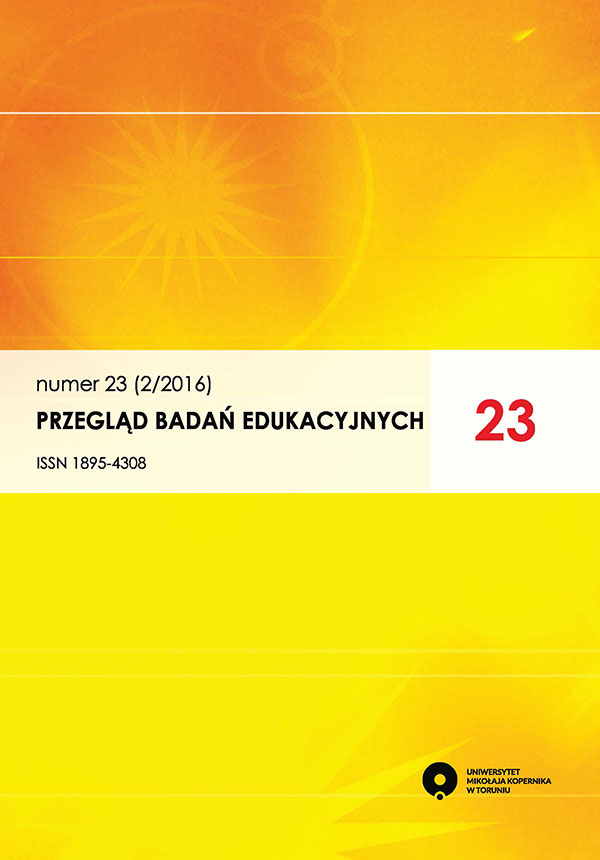Media Image of Children with Autistic Spectrum Disorders (ASD) Created by Their Blogging Parents
DOI:
https://doi.org/10.12775/PBE.2016.074Keywords
autism, parenting weblogs, media representation of disabilityAbstract
The paper discusses how children with some autistic spectrum disorders (ASD) are portrayed by their parents. In the first part we present autism and Asperger syndrome as medical cases, provide the definitions, characteristics and methods of therapy. Next, we analyze the media images of people with disabilities, including the stereotypic features emphasized in the media. Finally, we present the results of the study. The primary research problem refersto the question: What is the image of children with ASD that is created by the posts and memories on blogs written by their parents? The research is mostly qualitative. We applied an analysis of existing documents (internet diaries), which belong to a wider category of network ethnography (netnography). The analysis was conducted on 15 blogs. The results reveal that the actual image of a child with ASD is significantly different from a stereotypic images presented in the media. Blogs written by parents do not follow the stereotypes, and they rather focus on distinctive features and autonomy of the child. They mostly portray the children in context of hurdling various impediments and succeeding in small and larger matters, or outline their personal features and uniqueness. Therapies and treatments are considered as a means for realizing the dreams and plans of the child. Sometimes, autism is set in the background, as a part of everyday reality, which is not the object of the blog, but merely an intrinsic part of life. Children with ASD are usually portrayed in line with the common, scientifically documented features specific for similar disorders. Blogging parents appear to have considerable knowledge on ASD and describe their children from that perspective.
References
Attwood T. (1998), Asperger’s Syndrome: A Guide for Parents and Professionals, Jessica Kingsley Publishers, London.
Barnes C. (1997), Wizerunki niepełnosprawności i media – badanie sposobów przedstawiania osób niepełnosprawnych w środkach przekazu, Ogólnopolski Sejmik Osób Niepełnosprawnych, Warszawa, s. 19.
Błaszczyński J. (red.) (2013), Terapie wspomagające rozwój osób z autyzmem, Oficyna Wydawnicza
„Impuls”, Kraków.
Bobkowicz-Lewartowska L. (2014), Autyzm dziecięcy, Oficyna Wydawnicza IMPULS, Kraków.
Bowler D. (2007), Autism Spectrum Disorders. Psychological Theory and Research, John Wiley&Sons, Ltd., Chichester, England.
Całek G., Łuszczak H., Jankowska H. (2014), Mam dziecko z zespołem Aspergera. Poradnik dla rodziców, Polskie Towrzystwo Zespołu Aspergera, Warszawa.
Cichocki P., Jędrkiewicz T., Zydel R. (2012), Etnografia wirtualna, w: Badania jakościowe. Metody i narzędzia, t. 2, D. Jemielniak (red.), Wydawnictwo Naukowe PWN, Warszawa, s. 203–219.
Cieszyńska J. (2011), Wczesna diagnoza i terapia zaburzeń autystycznych. Metoda krakowska, Omega Stage Systems, Kraków.
Diagnostic and Statistical Manual of Mental Disorders (DSM-V) (2013), Autism Spectrum Disorders, American Psychiatric Association, Washington.
Draaisma D. (2009), Stereotypes of autism, “Philosophical Transactions”, 364(1522), pp. 1475–1480. DOI: 10.1098/rstb.2008.0324.
Frith U. (2005), Asperger i zespół Aspergera, w: Autyzm i zespół Aspergera, U. Frith (red.), Wydawnictwo Lekarskie PZWL, Warszawa, s. 4–45
Fundacja Synapsis (2016), Objawy autyzmu, http://synapsis.org.pl/autyzm/objawy, dostęp: 16.02.2016.
Howlin P., Baron-Cohen S., Hadwin J. (2000), Jak uczyć dzieci z autyzmem czytania umysłu, Wydawnictwo JAK, Kraków.
Hunt P. (1991), Discrimination: Disabled people and the media, “Contact”, No. 70, pp. 45–48.
ICD-10 (2016), International Classification of Diseases and Related Health Problems, World Health Organizations, Geneva, http://apps.who.int/classifications/icd10/browse/2016/en.
Jenkins H. (2007), Kultura konwergencji: Zderzenie starych i nowych mediów, Wydawnictwa Akademickie i Profesjonalne, Warszawa.
Kosno D. (2013), Zespół Retta – zaburzenia neurorozwojowe o podłożu genetycznym, w: Nieznane? Poznane. Zaburzenia rozwojowe u dzieci z rzadkimi zespołami genetycznymi i wadami wrodzonymi, M. Buchnat, K. Pawelczak (red.), Wydawnictwo Naukowe UAM, Poznań, ss. 157–176.
Kossowska A. (2015), Duże sprawy w małych głowach, Stowarzyszenie Terapeutów Zależnych, Opole.
Kozinets R.V. (2012), Netnografia. Badania etnograficzne online, Wydawnictwo Naukowe
PWN, Warszawa.
Kruk-Lasocka J. (1998), Pedagogika dzieci z autyzmem i zespołami psychozopodobnymi, w: Pedagogika specjalna, W. Dykcik (red.), Wydawnictwo Naukowe UAM, Poznań, s. 245–257.
Lauritsen M.B. (2013), Autism spectrum disorders, “European Child & Adolescent Psychiatry”, February 2013, Volume 22, Supplement 1, pp. 37–42. DOI: 10.1007/s00787-012-0359-5.
Łuczewski M., Bednarz-Łuczewska P. (2012), Analiza dokumentów zastanych, w: Badania jakościowe. Metody i narzędzia, D. Jemielniak (red.), t. 2, PWN, Warszawa, s. 163–185.
Midro A.T. (2010), Zespół Retta – postępy badań nad patogenezą, „Neurologia Dziecięca”, 19, 28; ss. 55–63.
Okoń W. (2003), Wprowadzenie do dydaktyki ogólnej, Wydawnictwo Akademickie „Żak”, Warszawa.
Olechnowicz H., Wiktorowicz R. (2012), Dziecko z autyzmem, Wydawnictwo Naukowe PWN, Warszawa.
Pisula E. (2000), Autyzm u dzieci. Diagnoza, klasyfikacja, etiologia, Wydawnictwo Naukowe PWN, Warszawa.
Pisula E. (2012), Autyzm. Od badań mózgu do praktyki psychologicznej, GWP, Sopot.
Preißmann Ch. (2013), Zespół Aspergera. Jak z nim żyć. Jak pomagać. Jak prowadzić terapię, Gdańskie Wydawnictwo Psychologiczne, Sopot.
Randall P., Parker J. (2001), Autyzm. Jak pomóc rodzinie, Gdańskie Wydawnictwo Psychologiczne, Gdańsk.
Strykowski W. (1997), Media w edukacji: od nowych technik nauczania do pedagogiki i edukacji medialnej, w: Media a edukacja, Strykowski W. (red.), eMPi2, Poznań, s. 11–20.
Wing L. (2005), Związek między zespołem Aspergera i autyzmem Kannera, w: Autyzm i zespół Aspergera, U. Frith (red.), Wydawnictwo Lekarskie PZWL, Warszawa, s. 115–149.
Downloads
Published
How to Cite
Issue
Section
Stats
Number of views and downloads: 2691
Number of citations: 0



